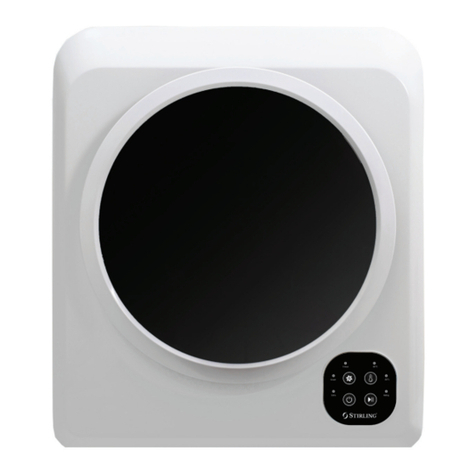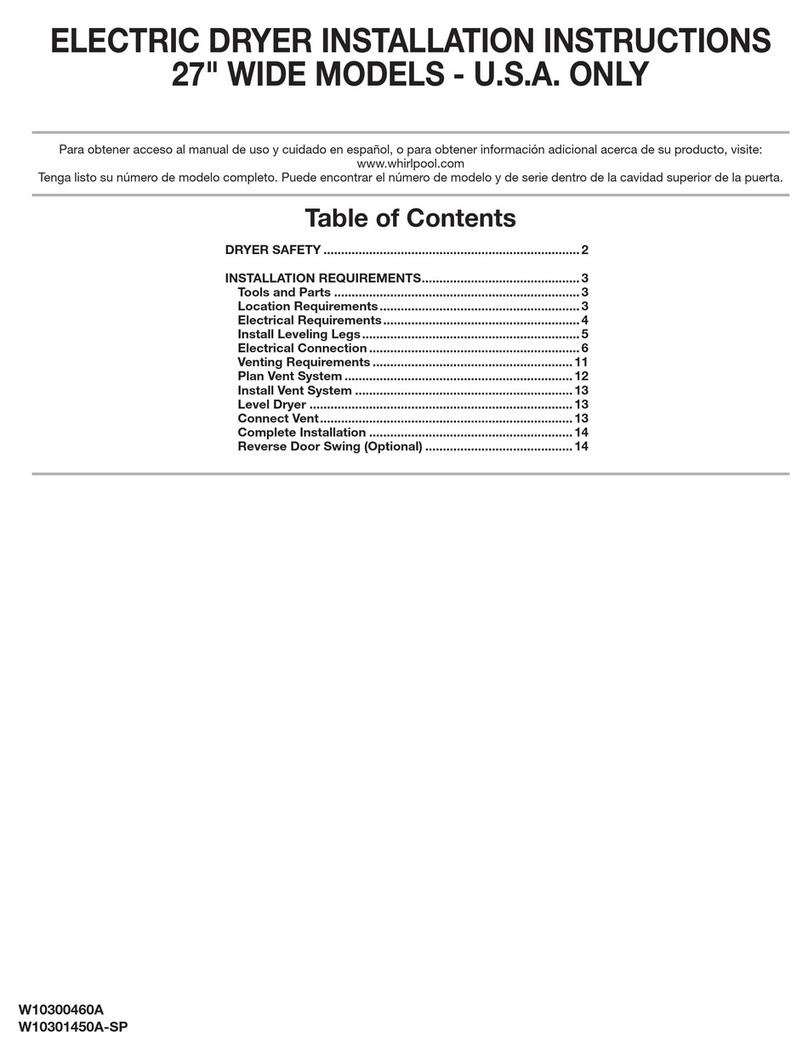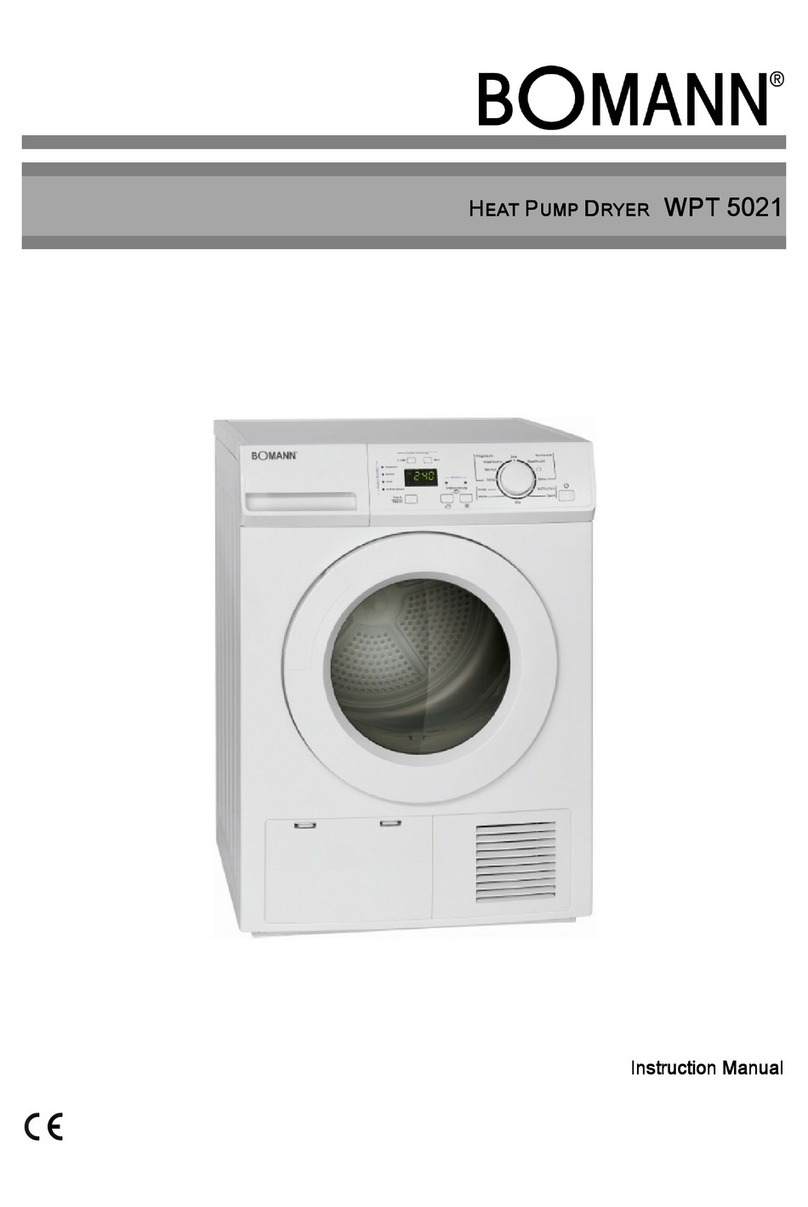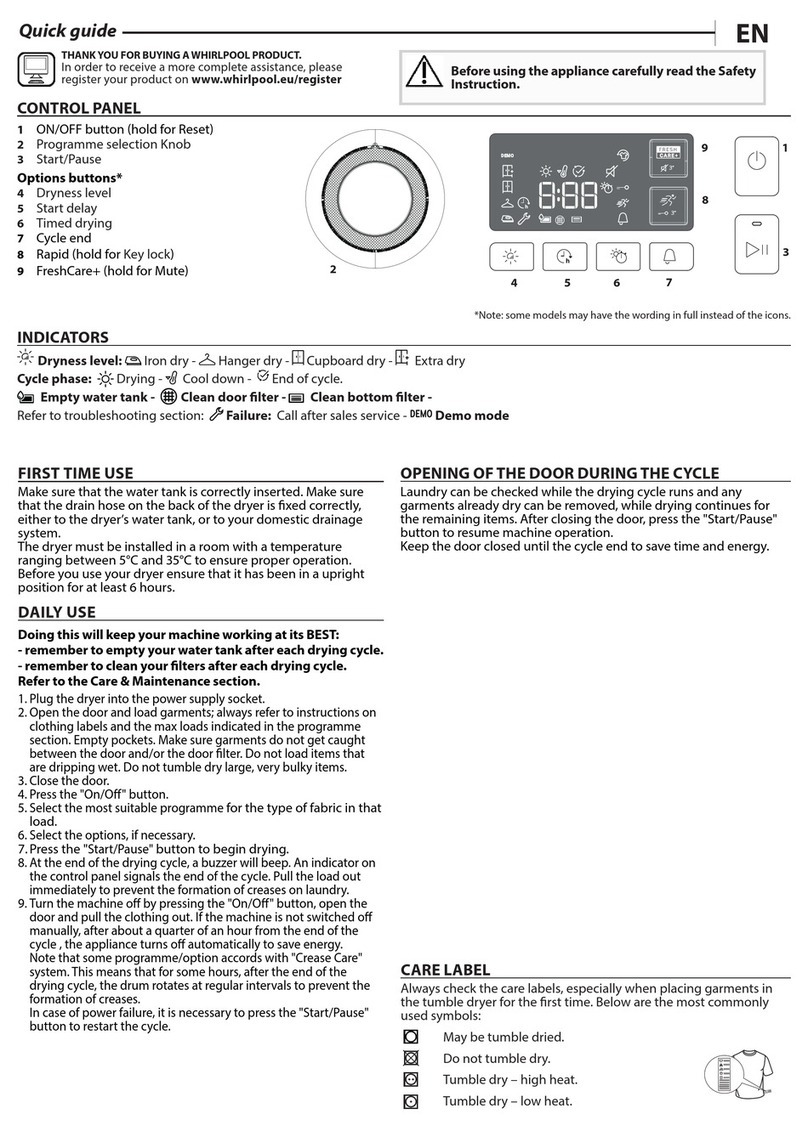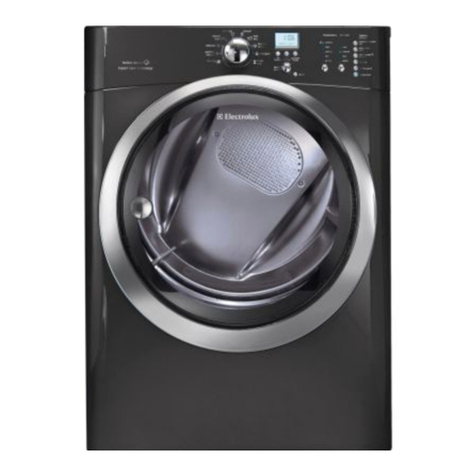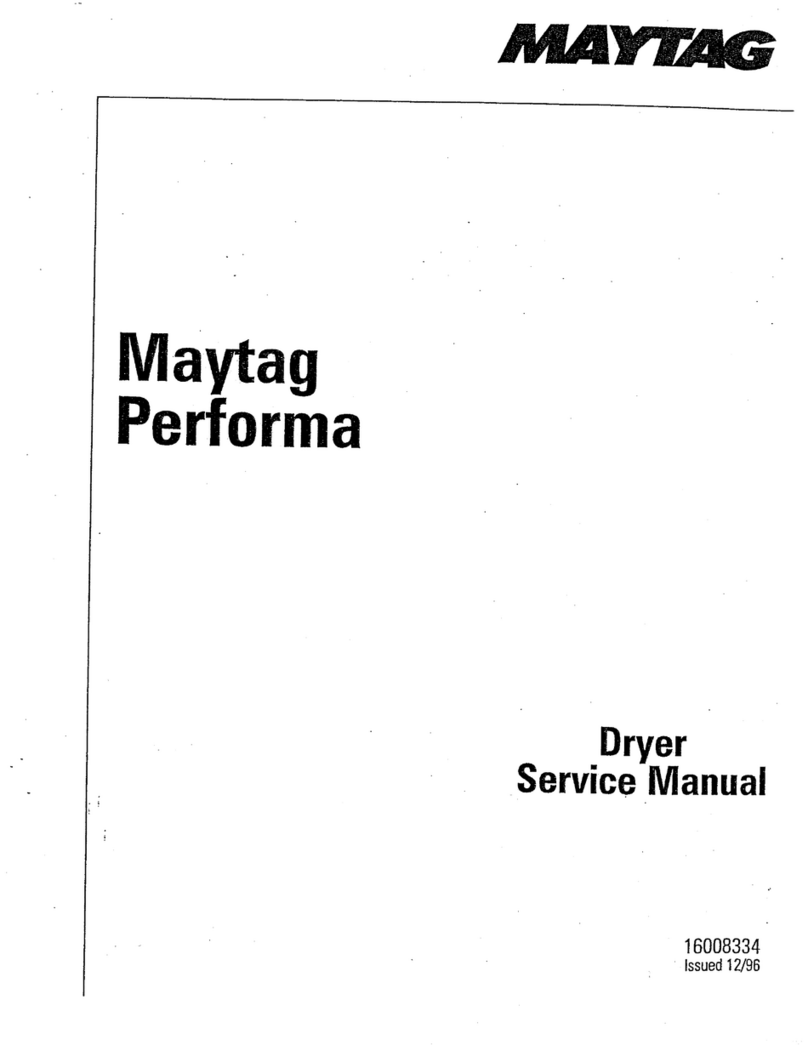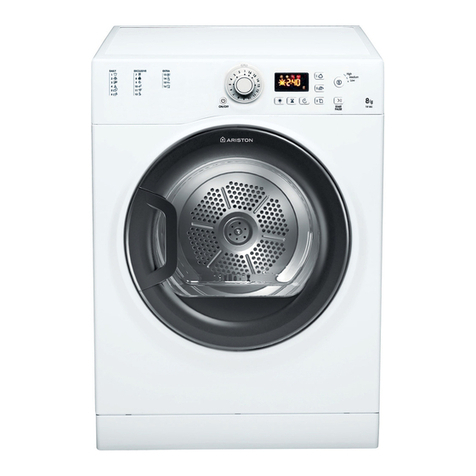Stirling GYJ45-68 User manual

Model Number GYJ45-68
N13275
4.5kg Clothes Dryer
INSTRUCTION MANUAL
AFTER SALES SUPPORT
1300 886 649
AUS MODEL: GYJ45-68 PRODUCT CODE: 52533 05/2016
IM Version No: V2.5 Issue Date: 03 February 2016

2
Welcome
Congratulations on choosing to buy a STIRLING®product.
All products brought to you by STIRLING®are manufactured to the highest standards
of performance and safety and, as part of our philosophy of customer service and
satisfaction, are backed by our comprehensive 3 Year Warranty. We hope you will
enjoy using your purchase for many years to come.

3
Contents
02 Welcome
04 Warranty Details
05 General Safety Instructions
08 Product Overview
10 Getting Started: Installation
15 Instructions
18 FAQs
19 Other Useful Information
23 Repair and Refurbished Goods or Parts Notice

4
Warranty Details
The product is guaranteed to be free from defects in workmanship and parts for
a period of 36 months from the date of purchase. Defects that occur within this
warranty period, under normal use and care, will be repaired, replaced or refunded at
our discretion, solely at our option with no charge for parts and labour. The benefits
conferred by this warranty are in addition to all rights and remedies in respect
of the product that the consumer has under the Competition and Consumer Act
2010 and similar state and territory laws.
Our goods come with guarantees that cannot be excluded under the Australian
Consumer Law. You are entitled to a replacement or refund for a major failure
and to compensation for any other reasonably foreseeable loss or damage. You
are also entitled to have the goods repaired or replaced if the goods fail to be of
acceptable quality and the failure does not amount to a major failure.
4.5kg Clothes Dryer
YEARS IN HOME
WARRANTY
3

5
General Safety Instructions
IMPORTANT SAFETY INSTRUCTIONS
READ CAREFULLY AND KEEP FOR FUTURE REFERENCE
Read this manual thoroughly before first use, the safety precautions enclosed herein
reduce the risk of fire, electric shock and injury when correctly adhered to. Keep the
manual in a safe place for future reference, along with the completed warranty card
and purchase receipt. If applicable, pass these instructions on to the next owner.
Always follow basic safety precautions and accident prevention measures when
using an electrical appliance, including the following:
Electrical safety and cord handling
• Voltage: Make sure your outlet voltage and circuit frequency correspond to the
voltage indicated on the appliance rating label and your outlet socket is properly
earthed. If this is not the case, do not use the dryer.
• Separate circuit: We strongly recommend you connect the appliance to a separate
circuit serving only this appliance. This provides the best performance and prevents
overloading the house wiring circuits that could cause a fire hazard from overheating.
• Electrical hazard: Do not insert any objects into the appliance.
• No extension cord: Do not use this appliance with a power adaptor or extension
cord. CAUTION: If such a device must be used, the cord or outlet device must be
positioned so that it is not subject to splashing or ingress of moisture.
• Protect the power cord. Do not kink or damage the power cord. Position the cord
out of the way so no one steps on or places anything on the cord or against it. Do
not run the cord under floor coverings. Arrange the cord away from traffic areas
where it will not become a trip hazard.
• Damage: Do not operate the appliance after it malfunctions or has been dropped
or damaged. In case of damage, contact the after sales support line for advice.
• Damaged cord: If the power supply cord is damaged, do not attempt to change
it yourself. A damaged cord or plug must be replaced by the manufacturer or a
qualified person in order to avoid a hazard.
• Disconnect: Unplug the clothes dryer from the power supply after use, before
cleaning, servicing or moving the appliance. To disconnect, turn the appliance off,
switch off the power outlet and remove the plug from the power outlet. Grip the
plug when disconnecting; do not pull on the cord. After disconnection, wait at least
2 minutes before turning the appliance back on again.
• RCD: Unless your home is already fitted with a residual current device (safety
switch), we recommend installing an RCD with a rated residual operating current
not exceeding 30mA to provide additional safety protection when using electrical
appliances. See your electrician for professional advice.
Usage conditions and restrictions
• Domestic use only: This appliance is intended for indoor household use only.
Do not use it outdoors. Do not use it for anything other than its intended purpose
(drying domestic quantities of washing), and only use it as described in this manual.

6
General Safety Instructions (Cont.)
• Usage restriction: The appliance is not intended for use by persons (including
children) with reduced physical, sensory or mental capabilities, or lack of
experience and knowledge, unless they have been given supervision or instruction
concerning use of the appliance by a person responsible for their safety.
• Children: Supervise young children to ensure they do not play with the dryer. Close
supervision is necessary when any appliance is used by or near children.
• Installation requirements: Do not install the appliance in a tight fitting cabinet.
Do not install it near heat sources such as radiators, heaters, air ducts or direct
sunlight. If the clothes dryer is not wall-mounted, place it on a flat, firm, dry and
stable floor in a well ventilated area. Use the adjustable legs to assist in levelling the
dryer if required. Do not place it on any soft material such as foam or plastic.
• Ventilation: Do not block any ventilation openings. Ensure that vents are not
covered by newspapers, tablecloths, curtains, etc.
• Before use: Make sure to remove transport packaging at the rear of the dryer.
WARNING: Before loading the dryer, always ensure no pet or young child has
climbed into it. Do not overload the clothes dryer.
• Suitability for tumble drying: Only load suitable items into the clothes dryer. See
the box on the opposite page for which items and materials are unsuitable for the
clothes dryer and may present a fire risk.
• Preparation: Make sure all pockets of clothing to be dried are empty. Hard, sharp
objects such as coins, safety pins, bra wires, nails, screws, lighters or matches
must be removed as they can cause extensive damage to the dryer.
WARNING: Any damage or malfunction resulting from foreign objects is not
covered by your warranty and may lead to expensive repairs.
• No dripping water: All clothes must be thoroughly spin-dried before placing them
in the dryer. Dripping water may cause an electrical hazard.
• No open flames: Do not place open flame sources such as candles on the dryer.
• Hot surface: The door window may be hot after a long drying cycle. Always ensure
children are kept away from the machine.
• Cool down: The final part of a clothes dryer cycle occurs without heat (cool down
cycle) to ensure that the items are left at a temperature that will not damage them.
WARNING: Never stop the clothes dryer before the end of the drying cycle unless
all items are removed quickly and spread out so that the heat is dissipated.
• Subsequent cycles: After turning off the power supply to the clothes dryer, wait at
least two minutes before turning it back on again.
• Repair: Except for the filters that require cleaning, this appliance contains no user-
serviceable parts inside. Do not attempt to open, disassemble or repair it yourself;
only have it serviced by qualified personnel, call the after sales support line.
• Liability: Improper use or installation may result in the risk of fire, electric shock
and/or injury. We assume no liability for any eventual damages caused by improper
use or handling, or by any other noncompliance with the instructions in this manual.

7
General Safety Instructions (Cont.)
CAUTION!
The items listed below are UNSUITABLE for clothes drying.
They can cause fire in the clothes dryer or extensive damage.
DO NOT place the following items into the clothes dryer.
:Items containing foam rubber (also known as latex foam) or similarly textured
rubber-like materials — when heated, these materials can spontaneously
combust and cause a fire.
:Items that have been spotted or soaked with cooking oil, or with highly flam-
mable substances — these substances constitute a fire hazard. Highly flam-
mable substances used in domestic environments include acetone, alcohol,
petrol, kerosene, some stain removers, dry-cleaning solvents, turpentine,
waxes, wax removers and some hair care products. (This also includes items
that have previously been cleaned or spotted with dry-cleaning solvents or
other flammable or explosive substances.)
Washing these items thoroughly beforehand in hot water with an extra amount
of detergent will reduce, but not necessarily eliminate the hazard. The ‘cool
down’ cycle of a clothes dryer should be used to reduce the temperature of the
items. They should not be removed from the clothes dryer or piled or stacked
while hot.
:Undergarments that contain metal reinforcements (such as underwire bras),
which can come loose during drying and damage the clothes dryer.
:Plastic articles such as shower caps or waterproof baby bibs.
:Rubber-backed articles, clothes fitted with foam rubber pads, pillows,
galoshes and rubber coated tennis shoes.
:Fabric softeners or similar products, unless they are specifically recommended
by the product manufacturer for use in a clothes dryer to eliminate the effects
of static electricity.
CAUTION!
• Do not use the tumble dryer if industrial chemicals have been used for cleaning.
• Do not dry unwashed items in the tumble dryer.
• Do not allow lint to accumulate around the tumble dryer. Clean the filter after every use.
• Adequate ventilation has to be provided to avoid the backflow of gases into the
room from appliances burning other fuels, including open fires.
This symbol alerts you to take care as oil-affected items can ignite
spontaneously, especially when exposed to heat, such as in a clothes
dryer. The items become warm, causing an oxidation reaction in the oil.
Oxidation creates heat. If the heat cannot escape, the items can become
hot enough to catch fire. Piling, stacking or storing oil-affected items can
prevent heat from escaping and so create a fire hazard.

8
5 6 7
Product Overview
1
2 43
Front view
Scope of delivery
A Clothes dryer
1 Door
2 Window
3 Door gasket
4 Drum
5 Heat selector button
6 Program selector/timer dial
7 Start button

9
Product Overview (Cont.)
Parts of the Wall-Mounting Kit
Part Illustration Quantity
Hanging brackets 2
Spacers 2
Exhaust Connector 1
12mm Screws 4
25mm Screws 4
16mm Screws 3
9
10 10
10 10
Low
High
8
Back view
C Wall-mounting kit
8 Air intake shroud
and filter
9 Exhaust vent
10 Mounting holes
B Documentation
(not shown)
Instruction manual
Quick start guide
Warranty certificate
Alternative printed
control panel

10
Unpacking
• This product has been packaged to protect it against transportation damage. When
unpacking keep all packaging until you have made sure your new clothes dryer is
undamaged and in good working order. The carton is recyclable. Whenever possible,
reuse the carton and recycle it when disposing of the packaging materials.
• Plastic wrapping can be a suffocation hazard for babies and young children, so ensure
all packaging materials are out of their reach. Dispose of packaging safely.
• Make sure to remove the transport packaging at the rear of the clothes dryer.
• Inspect the cord and plug for damage or wear before each use. Do not use the
appliance if the appliance or its cord have been damaged or are not working properly.
In case of damage, contact our after sales support line.
• Read all instructions in this manual and make sure you understand all warnings.
• Wipe the inside of the drum with a damp cloth to remove any dust from transport.
Important notes regarding installation
• This clothes dryer can be installed on the floor level (as supplied, or upside down with
the control panel at the top), or wall-mounted (as supplied). Detailed instructions for
each option are provided on the following pages.
• The appliance must not be installed behind a lockable door, sliding door or a door with
a hinge on the opposite side of the clothes dryer, in such a way that a full opening of
the tumble dryer door is restricted.
• Do not install the appliance in a tight fitting cabinet.
• Make sure that all electrical connections are made by qualified personnel and all
instructions in this manual as well as local safety regulations are observed.
• Place the dryer in a dry, well ventilated area, away from heat and direct sunlight.
• Exhaust air must not be discharged into a flue which is used for exhausting fumes
from appliances burning gas or other fuels.
Floor level installation
• If the dryer is installed on the floor, make sure to place it on a firm, flat, dry and stable
floor, close to an appropriate wall outlet. Do not place it on soft material such as foam,
plastic or carpet, as this will block the air intake.
• The dryer comes with legs to ensure stability. If you are
installing the appliance with the control panel at the
top), you will need to reassemble the legs on the bottom
panel. To avoid damaging the floor, lay the dryer on a
large piece of cardboard (from the dryer carton) and
attach the legs as illustrated (Fig. 1).
• See points 3 and 4 on page 13 for installation of the exhaust connector.
• Stand the dryer on its feet and slide it into position, leaving a space of at least 10cm
between the dryer and any wall. All four legs are adjustable; just turn them to assist in
levelling the dryer, if necessary. When the dryer is level, tighten the legs.
Getting Started: Installation
CAUTION: This appliance is heavy. Use two or more people to move and install it.
Fig. 1

11
Upside down installation
The dryer can be installed upside down, if this suits your setup better. To prepare the
unit for upside down installation, proceed as follows:
1. Remove the rubber plugs on the top of the unit (Fig. 2). Then remove the four legs
from the bottom (Fig. 3).
2. For installation on the floor, place the dryer upside down and install the four legs at
the bottom (top side of the original dryer, Fig. 4). (This step is not necessary if wall-
mounting the dryer or installing it on a rack above a washer. Do not put the dryer on
a washing machine or other appliance.) Push the rubber plugs into the holes on the
top of the dryer (bottom of the original dryer, see Fig. 5).
3. There is an additional printed control panel in the accessories bag, place this over
the existing panel (Fig. 6).
Getting Started: Installation (Cont.)
Fig. 2
Fig. 4 Fig. 5
Fig. 6
Fig. 3

12
Wall-mounted installation
• If wall-mounting the dryer above a washer, allow sufficient room to open the lid of
a top load washer.
• You will need at least 5cm space between the top of the dryer and the ceiling for
ease of installation.
• If you want to mount this dryer directly to your laundry wall, use the supplied
wall-mounting kit which contains the following parts:
Parts of the Wall-Mounting Kit
Part Illustration Quantity
Hanging brackets 2
Spacers 2
Exhaust Connector 1
12mm Screws 4
25mm Screws 4
16mm Screws 3
Getting Started: Installation (Cont.)
• Additional tools required (for mounting onto a plasterboard/wood stud wall):
* Drill (with a 3mm drill bit)
* Phillips head screwdriver
* 4 Timber screws (ø12x50mm)
* Helper to help lift the dryer onto the wall.
• Wall-mounting instructions follow on the next pages.
Rack-mounted installation
• If the clothes dryer is to be rack-mounted, you will need a secure stand (Fig. 7)
to ensure stability and prevent vibration. (The stand is not included.)
• Make sure to leave at least 10cm space between the dryer and the wall (Fig. 8).
Stand
Fig. 7 Fig. 8
Clearance

13
Step-by-step wall-mounting instructions
When mounting the clothes dryer to a plasterboard wall, make sure to attach the
wall-mounting bracket securely to a timber stud. If the space between two studs is
too wide, fit a timber slat between the studs to mount the brackets securely onto the
studs (Fig. 9).
1. Determine the dryer position on the wall and mark the required bracket position.
2. Fix the two wall-hanging brackets securely
to the timber stud (Fig. 10). Align the hanging
hooks and fasten the screws tightly.
Getting Started: Installation (Cont.)
3. To install the exhaust connector, push the
connector over the exhaust vent at the
back of the dryer with the exhaust outlet
in the direction required (Fig. 11).
4. Use the three 16mm screws to fix the
connector firmly in place.
Fig. 11
Fig. 10
Fig. 9
563mm 563mm 563mm

14
Getting Started: Installation (Cont.)
5. Use the four 12mm screws to attach the two spacers (Fig. 12).
Fig. 13
6. With assistance, mount the clothes
dryer onto the wall bracket (Fig. 13).
7. Once the clothes dryer is properly
installed, plug the electrical cord into
an appropriately earthed three pin
240V wall socket.
Fig. 12
Mounting
holes
Mounting holes
Spacers
12mm long screws
NOTE
If you are attaching a flexible
duct (not supplied) to the
exhaust outlet, make sure to
keep it as short as possible, as
long exhaust ducts reduce the
efficiency of the machine, and
may hinder its operation.

15
Instructions
Loading the dryer
• Prior to loading the dryer, check that none of the items have the following symbols
anywhere on them, which indicate that items are UNSUITABLE for clothes drying.
• The clothes dryer is intended only for drying textile material that has been washed
in water and well spin-dried. Dripping water may cause an electrical hazard.
• Ensure that the items to be dried do not have combustible materials or foreign
objects (such as lighters, hair pins, coins) inside pockets.
• Clean the lint filter before each use (see page 19)
and make sure it is properly in place.
• To avoid items getting tangled up in the dryer,
which results in uneven drying, we recommend
placing items into the dryer one at a time.
• Turn items with zippers inside out and fasten
buckles. This will also help reduce impact noise
when the items hit against the turning drum.
• As the dryer heat may permanently set stains, ensure you check prior to drying.
• Separate dark and light coloured items as you would do when washing.
• For best results, load the dryer with similar fabrics that take a similar period of
time for drying (see page 17 for suggested drying times).
• Place small, delicate items in a mesh bag; do not put too many items into one
bag. (It is not recommended to dry underwire bras in a clothes dryer.)
• When drying large items such as a blanket or sheets,
open the dryer door and shake out the item from time to
time, then place the item back in the dryer, close the door
and press Start. This will ensure even drying.
• CAUTION: Do not overload the dryer: the maximum
amount of dry textile material that can be dried in one
load is 4.5kg.
• When closing the dryer door prior to starting the unit, ensure that items are not
jammed in the door.
• Do not add items into the dryer while it is operating. However, if you do open the door
during operation, the safety switch will stop the dryer.
CAUTION!
Make sure you read all safety precautions in this manual and are aware of the items
(listed on page 7) that cause a hazard if placed in the clothes dryer.
Flip over items

16
Instructions (Cont.)
The control panel at the front of the clothes dryer consists of the Heat Selector, the
Drying Program Selector/Timer Dial and the Start Button.
3 Off
In the ‘Off’ position, no power is supplied to
the dryer.
7 Extra Dry program (150-200 minutes)
This program is suitable for drying large quantities or bulky items, and the dryer drum
is more than half full. Select ‘High’ heat and set the timer to more than 150 minutes.
6 Warm program (60-150 minutes)
If your items do not need residual moisture for easy ironing (such as towels), set the
Heat Selector to ‘High’ and the timer to between 60 and 150 minutes (depending on
the amount of items in the dryer). At this setting the dryer will thoroughly dry (and cool
down) items and, depending on the material, leave them as wrinkle-free as possible.
5 Mild dry program (30-60 minutes)
With the Heat Selector set to ‘Low’ and the
drying time set to 30-60 minutes, the dryer
will generate warm air to gently dry items that
are difficult to iron. This program is particularly
suitable for items such as cotton or linen shirts
that crease easily when they are completely
dry. Once the motor stops, the items will still
contain moisture, making ironing easier.
4 Cool program (0-20 minutes)
To help prevent creasing, the motor will
generate cool air towards the end of the drying
cycle to cool the items just dried.
1 Heat selector
Select ‘Low’ for delicate items made of silk, polyester or
other delicate fabrics. Select ‘High’ for particularly bulky
items or large quantities.
2 Drying program selector/timer dial
Turn the drying program selector/timer in
clockwise direction to set the drying time.
1
4
5
3
78
6
2
9

17
8 Air dry
Use this setting for airing items. No heat is generated, the items will only be refreshed
with cool air.
Suggested drying times
Drying Capacity Drying Time
High Low
Approximately 1kg Approximately 30min. Approximately 55min.
Approximately 2kg Approximately 60min. Approximately 110min.
Approximately 3kg Approximately 120min.
Approximately 4.5kg Approximately 200min.
Drying times can be affected by many factors, such as type of material, bulkiness of
the items, how full the dryer is, etc. The above list is only a guide.
Instructions (Cont.)
CAUTION: HOT SURFACE!
Do not touch the air intake during
a drying cycle: it will be hot.
9 Start button
After having set up the Heat Selector and Timer Dial, press the Start button. The dryer
will start and work until the program is finished. If the during this process the door is
opened or power is switched off, the dryer will stop working. In order to start the dryer
again after the door is closed or power is switched back on, you will need to push the
Start button, then the dryer will start working again.
NOTE: This Start button is only designed to start the dryer working. If you press this
button during the drying process, the dryer will not pause. In order to stop the
dryer, you must turn the timer dial to the Off position.

18
Problem Possible cause Solution
The timer dial
does not turn.
Is the power plug inserted firmly into
the wall socket?
Insert the power plug firmly.
The drum
does not turn.
Is the door closed?
Did you press the Start button?
Is the power plug firmly inserted?
Does the wall socket have power?
Close the door.
After setting up the Heat
Selector and Timer Dial, you
must press the Start button.
Insert the power plug firmly.
If power is switched on at the
wall socket, check the socket
with another appliance.
Hot air is not
blowing out.
Is the timer incorrectly set to cold air? Set the timer to hot air.
The washing is
not thoroughly
dried.
Are the front and back filters clogged?
Is there too much washing in the
dryer?
Have items been added while the
dryer is in operation?
Has the washing been twisted while
drying?
Is the dryer operating in a small and
poorly ventilated area?
Have you set the dryer to the Mild Dry
program (low heat and less than 60
minutes drying time)?
Check and clean the filters.
Reduce the amount of
washing in the dryer.
Dry damp items again for a
little longer.
Untwist the items and dry
them for a little longer.
Place the dryer in a well-
ventilated area.
Try using the Warm or Extra
Dry settings instead (high
heat and more than 60
minutes drying time).
The dryer does
not start.
Is there a power failure?
Is the power plug inserted firmly?
Is the door closed?
Is the timer in the OFF position?
Is the power switched on at the wall
socket?
Check and try again when the
power is back.
Insert the power plug firmly.
Close the door securely.
Set the drying time.
Switch on power at the wall
socket.
Troubleshooting guide
If your clothes dryer has a fault, is not working properly, or you think it should work
better, use the list below to identify and solve any problems. If you cannot solve the
problem, contact our after sales support line. Do not attempt to dismantle or repair the
dryer yourself.
FAQs

19
Other Useful Information
Maintenance
To prolong the service life of your clothes dryer, keep it in good condition and clean
the filters regularly.
Cleaning the lint filter
The lint filter must be in place whenever drying. It must be cleaned before each use.
1. To remove the filter, insert your fingers into the four holes around the exhaust vent
shroud and pull out the filter assembly. It consists of three parts: the exhaust vent
shroud, the lint filter and the exhaust filter (Fig. 14).
CAUTION: Before cleaning or maintenance, unplug the dryer from the wall socket.
The filter is affixed to
the back of the drum.
2. Separate the three parts (exhaust vent shroud, lint filter and exhaust filter) and,
using a soft brush or vacuum cleaner, clean any lint off the lint filter and exhaust
filter (Fig. 15). Take care not to damage the filters.
3. After cleaning, assemble the parts in the sequence of exhaust filter - lint filter
- exhaust vent shroud (Fig. 16), aligning the recesses in the centre with the
projection in the centre of the drum. Make sure that the filter assembly is firmly
inserted.
NOTE: The metal grid fixed on the rear of the drum should also be cleaned with a
soft cloth or brush.
Fig. 14
Fig. 16
Exhaust Lint Exhaust
vent shroud filter filter
Fig. 15
Lint filter Lint Exhaust filter Dust cleaner

20
Other Useful Information (Cont.)
Cleaning the interior and exterior of the dryer
• To clean the exterior surfaces of the clothes dryer, only use a dry cloth, or a cloth
dampened with water and a little mild detergent.
• Do not wash exterior or interior surfaces directly with water.
• Do not use solvents, thinner, alcohol based or harsh or abrasive cleaners on any
of the dryer surfaces.
• Do not use any type of spray cleaner when cleaning the interior. If the dryer drum
becomes stained, clean the drum with a damp cloth.
• If cleaning the drum has left any residues on the drum, make sure to remove it
before drying the next load.
Cleaning the air intake filter
• The air intake filter at the front of the unit should be cleaned about once a month.
• To remove the filter, hold the upper and lower ends of the air intake shroud and
pull it outwards (Fig. 17).
• Remove the filter inside the shroud and clean it with a soft brush.
• Reassemble and push the filter back until it clicks into place.
Slightly push the shroud
upwards with your
thumb until the latch
hook disconnects, then
remove.
Fig. 17
Table of contents
Other Stirling Dryer manuals
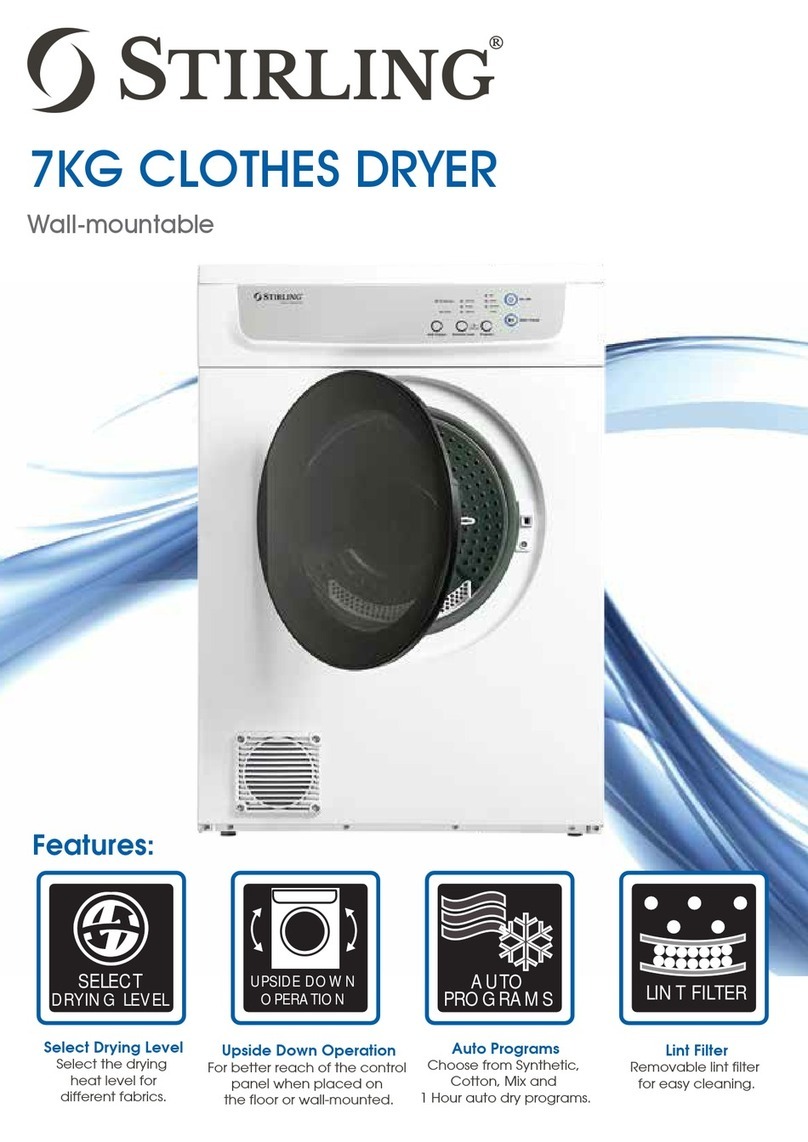
Stirling
Stirling MDR70-VR031 User manual
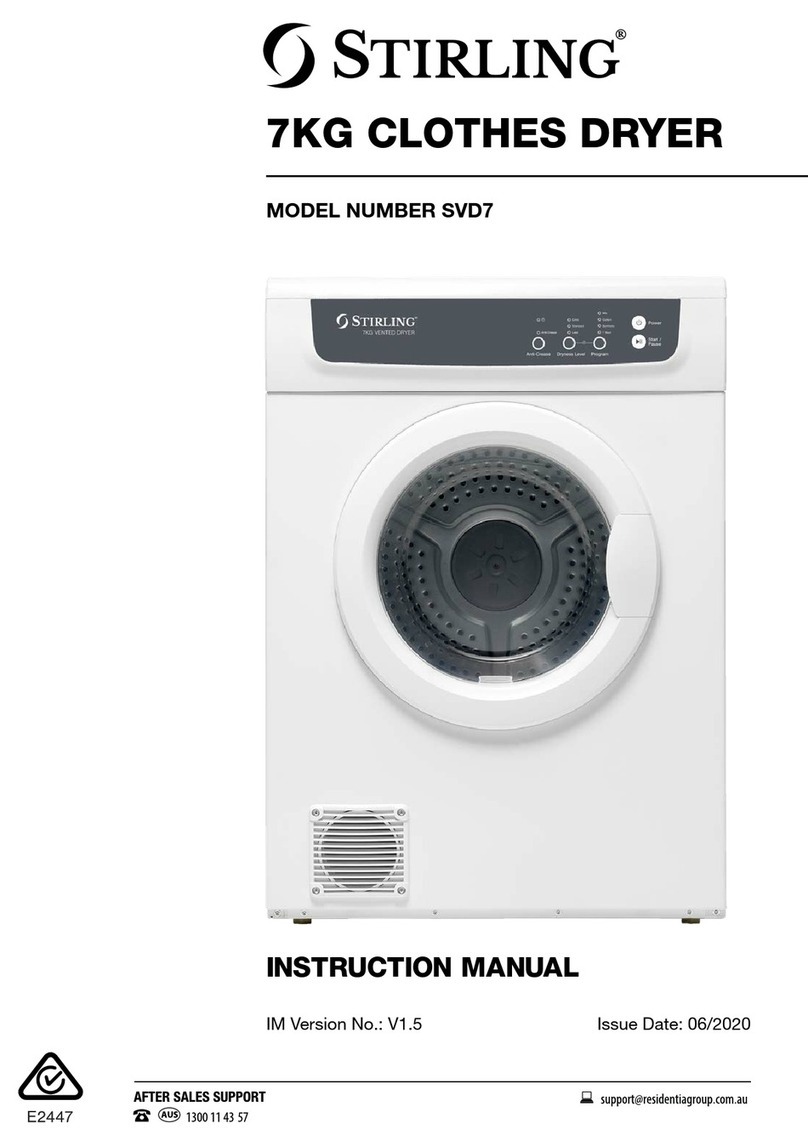
Stirling
Stirling SVD7 User manual

Stirling
Stirling GYJ40-88 User manual
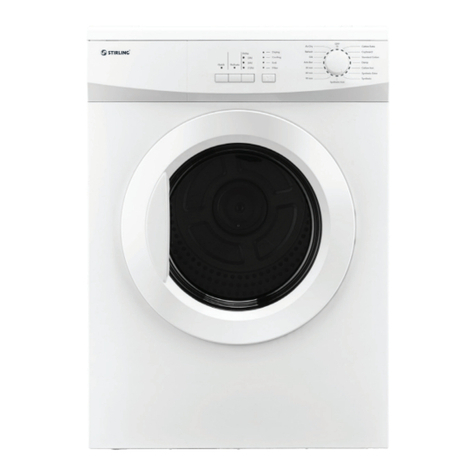
Stirling
Stirling STR-CD70W User manual
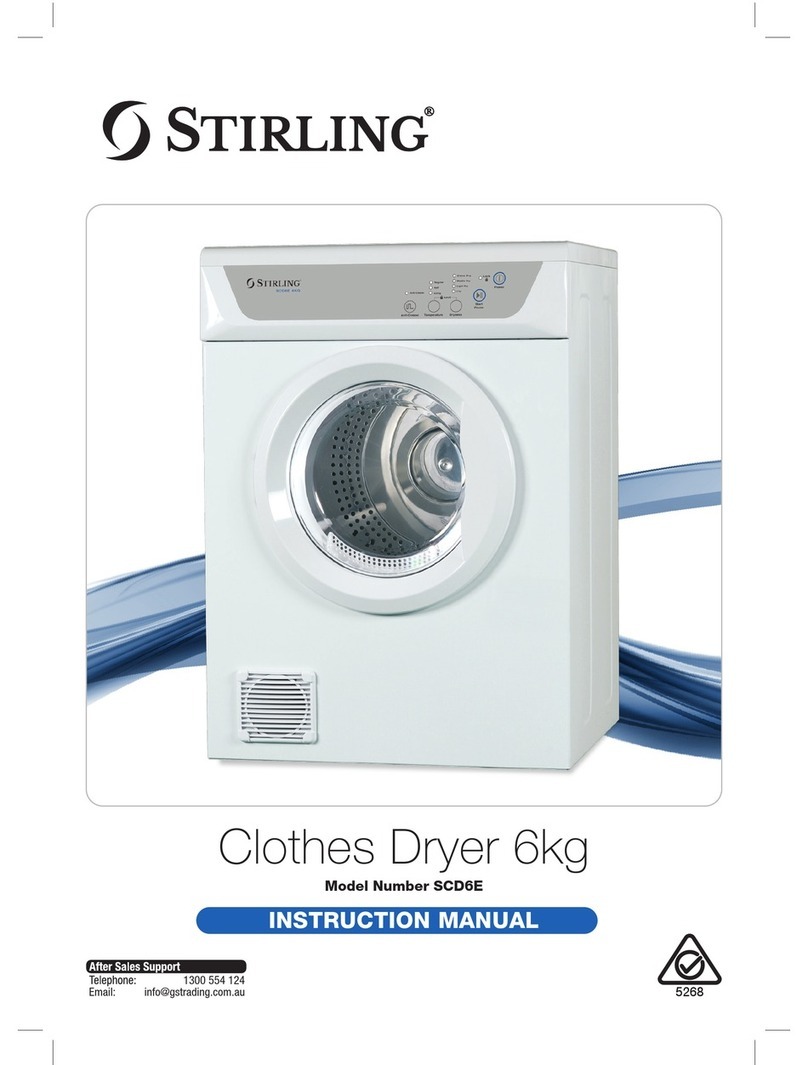
Stirling
Stirling SCD6E User manual
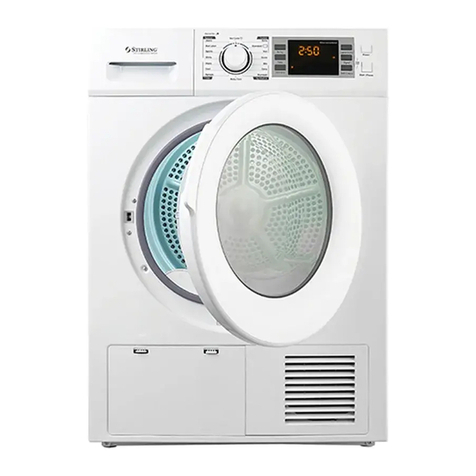
Stirling
Stirling STR-CD8C User manual
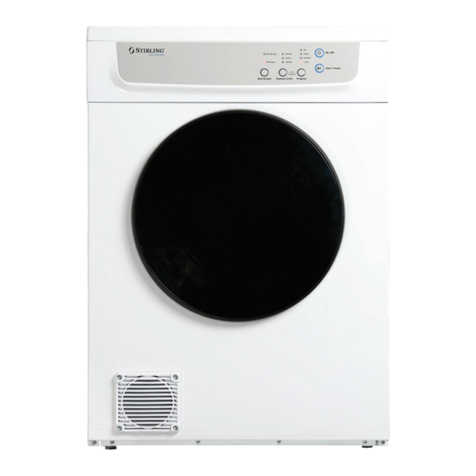
Stirling
Stirling MDR70-VR031 User manual
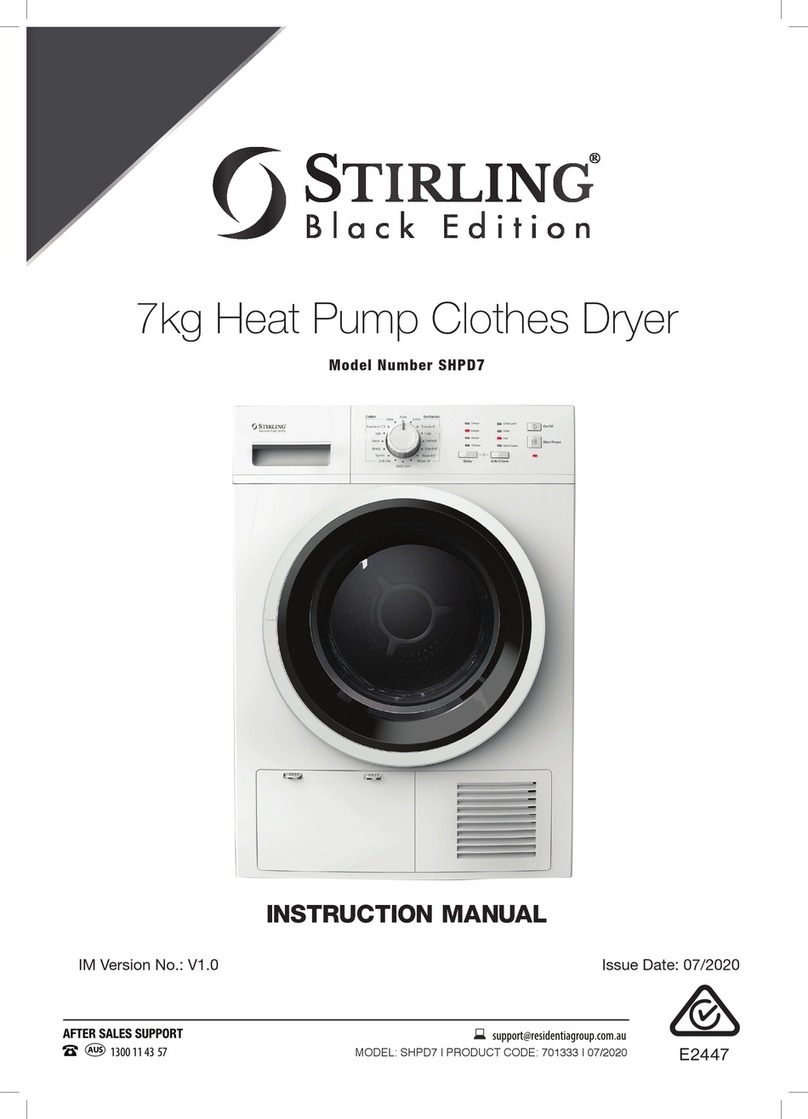
Stirling
Stirling SHPD7 User manual
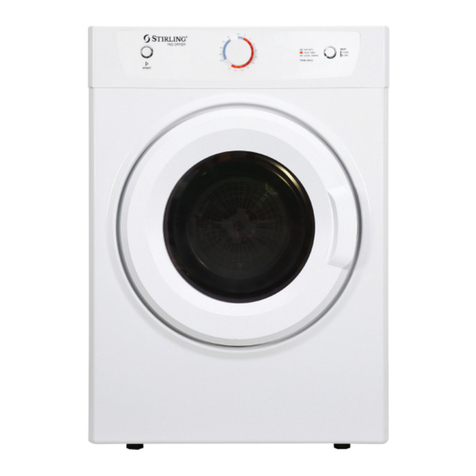
Stirling
Stirling SVDM70 User manual
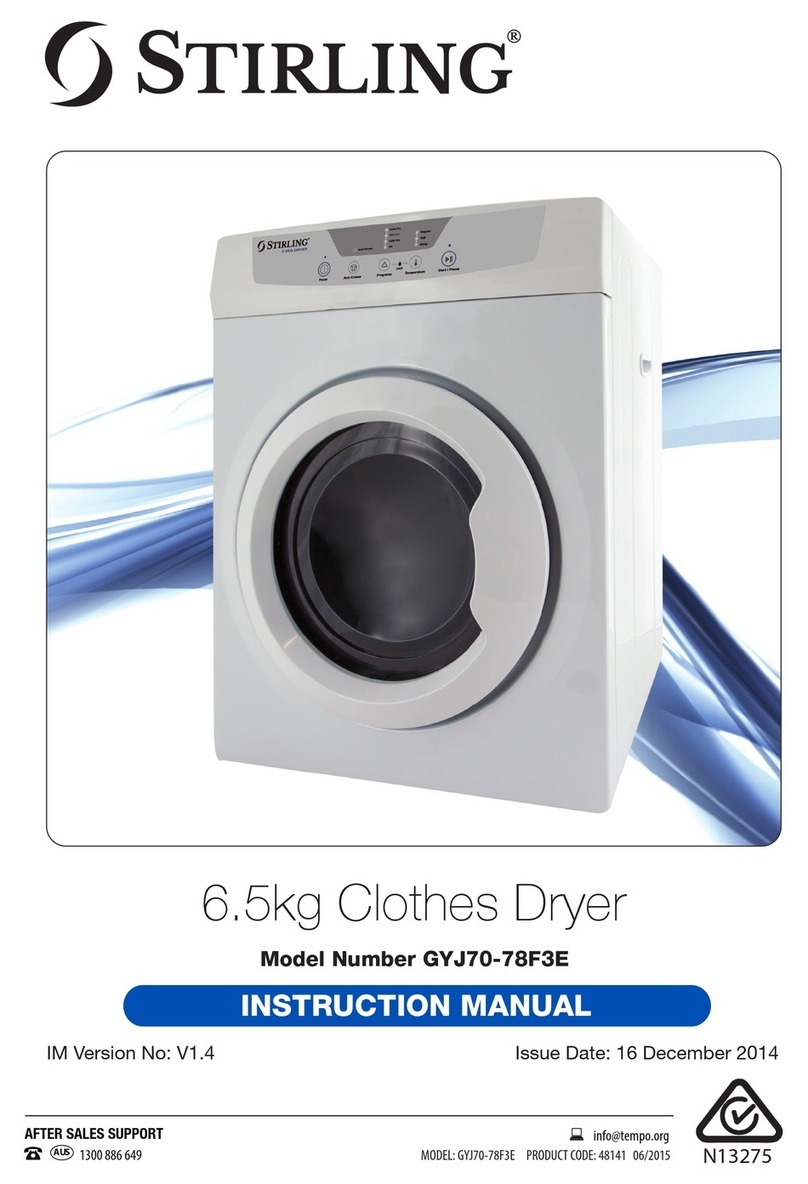
Stirling
Stirling GYJ70-78F3E User manual
Popular Dryer manuals by other brands

Frigidaire
Frigidaire GLER341AS0 operating instructions

Bosch
Bosch WQG245RASN User manual and installation instructions

Electrolux
Electrolux EIMED55HIW Use & care guide
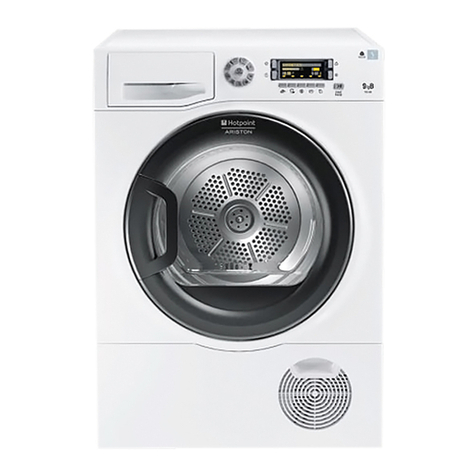
Hotpoint Ariston
Hotpoint Ariston TCD 93B Instruction booklet
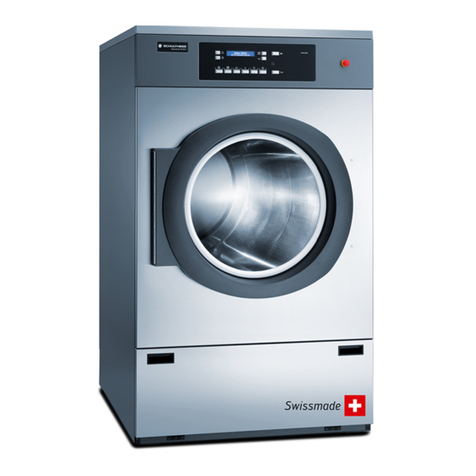
Schulthess
Schulthess TRI 9250 Instructions for use
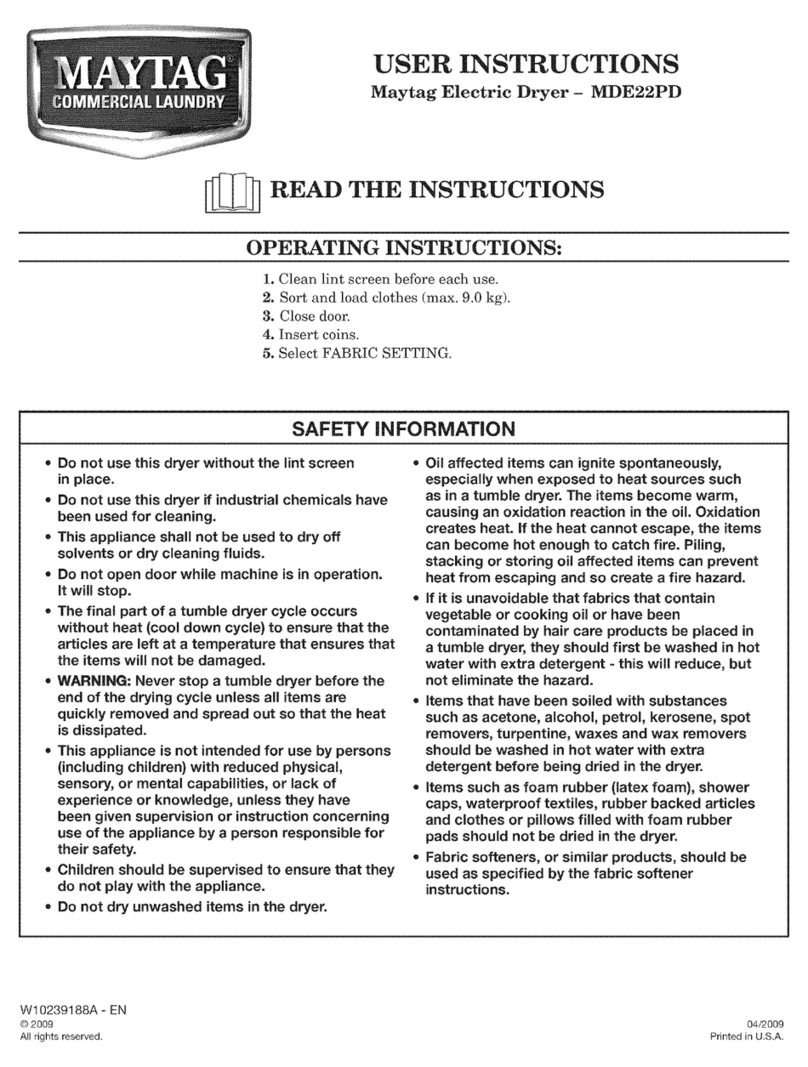
Maytag
Maytag MDE22PD User instructions

